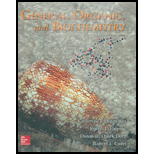
Concept explainers
(a)
Interpretation:
Correct IUPAC name for the structure given has to be written.

Concept Introduction:
A common nomenclature of naming organic compounds has been developed by IUPAC. By usage of this nomenclature or rules, memorizing of names of organic compounds is not necessary.
IUPAC rules for naming
There are about five rules that has to be followed for naming an alkene and an alkyne. They are,
- The longest continuous carbon chain in the compound that contains double bond or triple has to be identified. This is known as parent compound.
- Suffix “–ane” (in name of
alkane ) is replaced with “-ene” for alkene or “-yne” for alkyne. - Numbering has to be done so that the lowest number is given to the double or triple bond.
- Naming and numbering has to be given for each atom or group that is attached to the parent chain. Numbering has to be done in a way that substituents get the least numbering.
- If the alkenes have more than one double bond they are called as alkadienes (two double bonds) or alkatrienes (three double bonds). Appropriate suffix has to be used depending on the number of multiple bonds present in the compound.
(a)
Explanation of Solution
Given compound and IUPAC name is.

IUPAC name given is wrong as the triple bond is not given the least numbering. Correct IUPAC name for the given structure can be given as shown below.
Longest carbon chain with triple bond is found to contain six carbon atoms. Therefore, the parent alkane is hexane. As a triple bond is present, the alkyne name is hexyne.
Numbering has to be given in a way that the triple bond gets the least numbering. In this case, triple bond is present between carbon-2 and carbon-3. Therefore, the parent alkyne is 2-hexyne.

The substituent present in the given structure are a methyl group on carbon-5. Number has to be added before the substituent names which indicate the carbon atom in which it is present. This gives the name of alkene as 5-methyl-2-hexyne.

Longest carbon chain containing triple bond is hexane. Position of triple bond is 2-hexyne. Substituent present in the chain is 5-methyl. Correct IUPAC name of the structure given is 5-methyl-2-hexyne.
(b)
Interpretation:
Correct IUPAC name for the structure given has to be written.
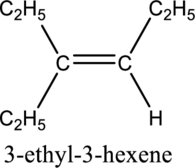
Concept Introduction:
Refer part (a).
(b)
Explanation of Solution
Given compound and IUPAC name is.
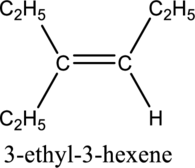
Longest carbon chain with double bond is found to contain six carbon atoms. Therefore, the parent alkane is hexane. As a double bond is present, the alkene name is hexene.
Numbering has to be given in a way that the triple bond gets the least numbering. In this case, triple bond is present between carbon-3 and carbon-4. Therefore, the parent alkyne is 3-hexene.
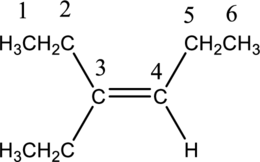
The substituent present in the given structure are an ethyl group on carbon-3. Number has to be added before the substituent names which indicate the carbon atom in which it is present. This gives the name of alkene as 3-ethyl-3-hexene.
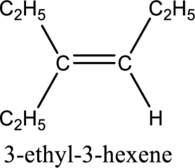
Longest carbon chain containing double bond is hexene. Position of double bond is 3-hexene. Substituent present in the chain is 3-ethyl. IUPAC name of the structure given is 3-methyl-3-hexene. Therefore, the given name is correct.
(c)
Interpretation:
Correct IUPAC name for the structure given has to be written.

Concept Introduction:
Refer part (a).
(c)
Explanation of Solution
Given compound and IUPAC name is.

IUPAC name given is wrong as the parent chain considered and the substituents are not given correctly. Correct IUPAC name for the given structure can be given as shown below.
Longest carbon chain with triple bond is found to contain nine carbon atoms. Therefore, the parent alkane is nonane. As a triple bond is present, the alkyne name is nonyne.
Numbering has to be given in a way that the triple bond gets the least numbering. In this case, triple bond is present between carbon-4 and carbon-5. Therefore, the parent alkyne is 4-nonyne.
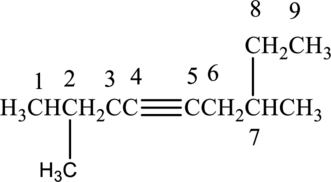
The substituent present in the given structure two methyl groups, each on carbon-2 and carbon-7. Number has to be added before the substituent names which indicate the carbon atom in which it is present. This gives the name of alkyne as 2,7-dimethyl-4-nonyne.

Longest carbon chain containing triple bond is nonane. Position of triple bond is 4-nonyne. Substituent present in the chain is 2,7-dimethyl. Correct IUPAC name of the structure given is 2,7-dimethyl-4-nonyne.
(d)
Interpretation:
Correct IUPAC name for the structure given has to be written.
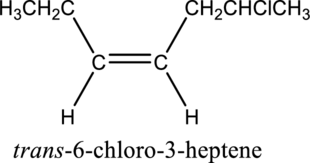
Concept Introduction:
Refer part (a).
(d)
Explanation of Solution
Given compound and IUPAC name is.
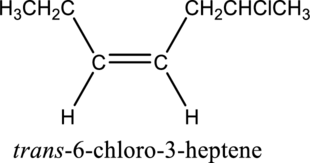
The configuration given in the IUPAC name is wrong as both hydrogen atoms are present on same side of the double bond. Correct IUPAC name can be given as shown below.
Numbering has to be given in a way that the double bond gets the least numbering. In this case, double bond is present between carbon-3 and carbon-4. Therefore, the parent alkyne is 3-heptene.
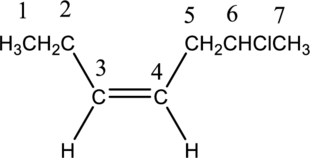
The substituent present in the given structure is a chloro group. Number has to be added before the substituent names which indicate the carbon atom in which it is present. This gives the name of alkene as 6-chloro-3-heptene. Looking into the stereo information, there are hydrogen atoms present on the same side of the double bond. Hence, the structure given is in cis conformation. Therefore, the name of the structure can be given as cis-6-chloro-3-heptene.
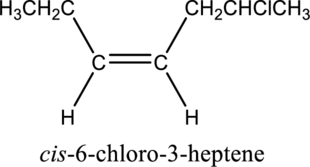
Longest carbon chain containing double bond is heptene. Position of double bond is 3-heptene. Substituent present in the chain is 6-chloro. Configuration is “cis”. Correct IUPAC name of the structure given is cis-6-chloro-3-heptene.
(e)
Interpretation:
Correct IUPAC name for the structure given has to be written.
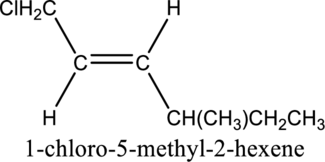
Concept Introduction:
Refer part (a).
(e)
Explanation of Solution
Given compound and IUPAC name is.
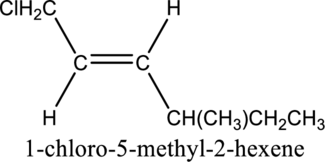
The configuration given in the IUPAC name is wrong as configuration is not given and the position of methyl substituent is wrong. Correct IUPAC name can be given as shown below.
Parent carbon chain is found to contain six carbon atoms. Therefore, the alkane is hexane.
Numbering has to be given in a way that the double bond gets the least numbering. In this case, double bond is present between carbon-2 and carbon-3. Therefore, the parent alkyne is 2-hexene.
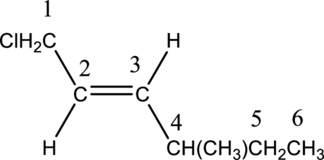
The substituent present in the given structure are a chloro group and a methyl group. Number has to be added before the substituent names which indicate the carbon atom in which it is present. This gives the name of alkene as 1-chloro-4-methyl. Looking into the stereo information, there are hydrogen atoms present on opposite side of the double bond. Hence, the structure given is in trans conformation. Therefore, the name of the structure can be given as trans-1-chloro-4-methyl2-hexene.
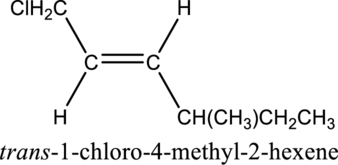
Longest carbon chain containing double bond is hexene. Position of double bond is 2-hexene. Substituent present in the chain is 1-chloro-4-methyl. Configuration is “trans”. Correct IUPAC name of the structure given is trans-1-chloro-4-methyl-2-hexene.
Want to see more full solutions like this?
Chapter 11 Solutions
GENERAL,ORGANIC,+BIOCHEM.(LL) >CUSTOM<
- 8:17 PM Sun Mar 30 Draw the major product of this reaction. Ignore inorganic byproducts. HSCH2CH2CH2SH, BF3 Probler Drawing Ato Bonds Clarrow_forwardpresented by Mr L How the coprion. (Il Done in no wraction, dew the starting redential) доarrow_forward8:16 PM Sun Mar 30 K Draw the major product of this reaction. Ignore inorganic byproducts. Proble 1. CH3MgBr 2. H3O+ F Drawingarrow_forward
- о но оarrow_forwardName the major organic product of the following action of 4-chloro-4-methyl-1-pentanol in neutral pollution 10+ Now the product. The product has a molecular formula f b. In a singly hain, the starting, material again converts into a secule with the molecular kormula CIO. but with comply Draw the major organic structure inhalationarrow_forwardMacmillan Learning Alcohols can be oxidized by chromic acid derivatives. One such reagent is pyridinium chlorochromate, (C,H,NH*)(CICTO3), commonly known as PCC. Draw the proposed (neutral) intermediate and the organic product in the oxidation of 1-butanol by PCC when carried out in an anhydrous solvent such as CH₂C₁₂. PCC Intermediate OH CH2Cl2 Draw the intermediate. Select Draw Templates More с H Cr о Product Draw the product. Erase Select Draw Templates More H о Erasearrow_forward
- If I have 1-bromopropene, to obtain compound A, I have to add NaOH and another compound. Indicate which compound that would be. A C6H5 CH3arrow_forwardProvide the reagents for the following reactions.arrow_forwardIf I have 1-bromopropene, to obtain compound Z, I have to add two compounds A1 and A2. Indicate which compounds are needed. P(C6H5)3arrow_forward
- Draw the major product of this reaction. Ignore inorganic byproducts. Assume that the water side product is continuously removed to drive the reaction toward products. O CH3CH2NH2, TSOH Select to Draw >arrow_forwardPredict the major organic product(s) for the following reaction.arrow_forwardPredict the major organic product(s) for the following reactions.arrow_forward
 ChemistryChemistryISBN:9781305957404Author:Steven S. Zumdahl, Susan A. Zumdahl, Donald J. DeCostePublisher:Cengage Learning
ChemistryChemistryISBN:9781305957404Author:Steven S. Zumdahl, Susan A. Zumdahl, Donald J. DeCostePublisher:Cengage Learning ChemistryChemistryISBN:9781259911156Author:Raymond Chang Dr., Jason Overby ProfessorPublisher:McGraw-Hill Education
ChemistryChemistryISBN:9781259911156Author:Raymond Chang Dr., Jason Overby ProfessorPublisher:McGraw-Hill Education Principles of Instrumental AnalysisChemistryISBN:9781305577213Author:Douglas A. Skoog, F. James Holler, Stanley R. CrouchPublisher:Cengage Learning
Principles of Instrumental AnalysisChemistryISBN:9781305577213Author:Douglas A. Skoog, F. James Holler, Stanley R. CrouchPublisher:Cengage Learning Organic ChemistryChemistryISBN:9780078021558Author:Janice Gorzynski Smith Dr.Publisher:McGraw-Hill Education
Organic ChemistryChemistryISBN:9780078021558Author:Janice Gorzynski Smith Dr.Publisher:McGraw-Hill Education Chemistry: Principles and ReactionsChemistryISBN:9781305079373Author:William L. Masterton, Cecile N. HurleyPublisher:Cengage Learning
Chemistry: Principles and ReactionsChemistryISBN:9781305079373Author:William L. Masterton, Cecile N. HurleyPublisher:Cengage Learning Elementary Principles of Chemical Processes, Bind...ChemistryISBN:9781118431221Author:Richard M. Felder, Ronald W. Rousseau, Lisa G. BullardPublisher:WILEY
Elementary Principles of Chemical Processes, Bind...ChemistryISBN:9781118431221Author:Richard M. Felder, Ronald W. Rousseau, Lisa G. BullardPublisher:WILEY





